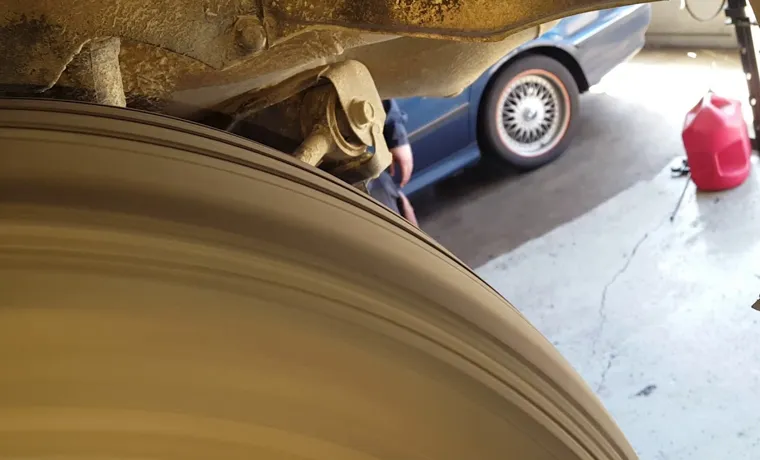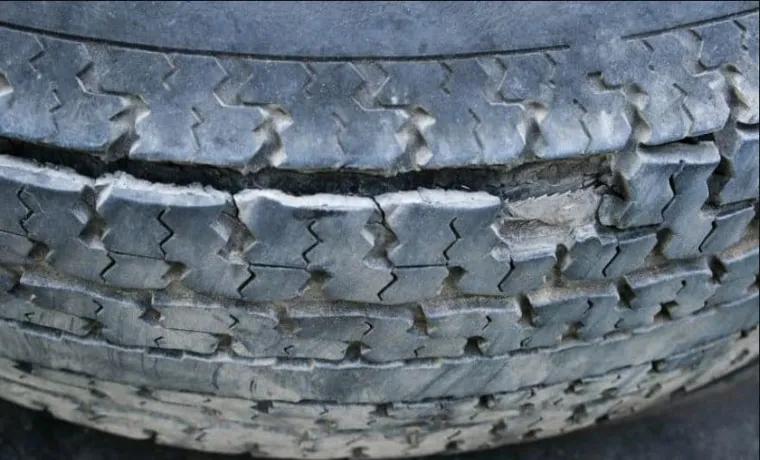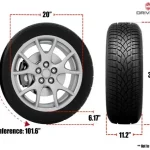Nothing can be more frustrating than experiencing a car issue, especially on the open road. While driving along, you may start to notice an unusual vibration coming from your car’s tires. This vibration could be a tell-tale sign of a broken tire belt.
Although it may not seem like a big deal, a broken tire belt can be a serious problem that needs to be addressed as soon as possible. But, what exactly is a tire belt, and how does it feel when it breaks? Here’s what you need to know. Tire belts are steel cables that are wrapped around the tire to maintain rigidity and shape.
When a tire’s belt is damaged, it can result in significant tire tread separation. This separation can cause the tire to become misshapen, leading to a vibration that is most noticeable at higher speeds. If you’re driving, the car may start to feel unstable, and the steering wheel may start to vibrate, making it difficult to handle the vehicle.
Driving with a broken tire belt can be incredibly dangerous, leading to a tire blowout or loss of control of the vehicle. It is important to take immediate action if you notice any of these symptoms. Get your car inspected by a mechanic to determine if the tire belt needs repairing or needs to be replaced entirely.
In conclusion, a broken tire belt is not something you want to ignore while driving. While the warning signs may be subtle at first, it can quickly escalate into a serious problem that affects the safety of the vehicle. If you notice any vibrations, instability, or difficulty in handling the car, have it inspected as soon as possible.
Don’t take any chances when it comes to your safety on the road.
Table of Contents
What Causes a Broken Tire Belt?
If you’ve ever experienced a broken belt in your tire, then you know the feeling. It’s not a pleasant one. But what does a broken belt in a tire feel like? Well, for starters, you may notice a bumping or thudding sensation as you drive.
You may also feel some vibration, especially at higher speeds. Additionally, you may notice that your tire is starting to wear unevenly, with one side showing more wear than the other. These symptoms are all signs of a broken tire belt, which happens when the layers of rubber and fabric that make up the tire’s structure come apart.
This can be caused by a variety of factors, from poor manufacturing to rough road conditions. Whatever the cause, it’s important to get your tire checked out as soon as possible to avoid further damage and ensure your safety on the road.
Overload and Under-inflation
A broken tire belt can be caused by a combination of factors, including overload and under-inflation of tires. When tires are not inflated to the recommended pressure, they become less stable and more prone to damage. This can cause the tire belt to weaken and eventually break.
Similarly, when a vehicle is overloaded with excessive weight, it puts extra pressure on the tires, causing them to wear out faster. If the tire belt is already weakened, this added pressure can cause it to break. It’s important to properly maintain your vehicle’s tires by regularly checking the tire pressure and weight limits, and ensuring that they are within the recommended range.
By doing so, you can avoid the risk of a broken tire belt and potential accidents on the road.

Potholes and Road Hazards
Potholes and Road Hazards Have you experienced a wobbly or bumpy ride lately, even on a relatively smooth road? Chances are, you might have a broken tire belt. The tire belt, also known as the steel belt, is a layer of metal cords coated with rubber that adds strength and stability to the tire. When this layer breaks, it can cause your tire to slip, bulge, or even blowout, especially when driving at high speeds.
But what causes a tire belt to break in the first place? One of the main culprits is road hazards, such as potholes, debris, or sharp objects. When you hit a pothole or object on the road, the impact can cause the tire to flex and bend, putting extra stress on the tire belt. Over time, this can weaken and break the metal cords, leading to a compromised tire.
So, if you notice any unusual vibrations, bumps, or bulges in your tires, it’s crucial to have them checked by a professional mechanic. Remember, a smooth ride starts with a healthy set of tires!
Excessive Wear and Tear
Excessive wear and tear can cause a broken tire belt. When tires are constantly subjected to harsh driving conditions, such as fast speeds, dramatic temperature changes, and rough terrain, the internal structure of the tire can become compromised. Over time, this can lead to the steel belts within the tire to break apart and cause bulges or flat spots on the tire’s surface.
Additionally, running over potholes or curbs can cause immediate damage to the tire, including breaking the belt. It’s important to regularly inspect your tires and check for signs of wear, such as uneven tread wear, cracks, or bulges. If you notice any of these signs, it’s important to have your tires replaced to avoid the risk of a blowout on the road.
By taking care of your tires and driving responsibly, you can help prevent a broken tire belt from occurring.
Signs of a Broken Tire Belt
If you’re wondering “what does a broken belt in a tire feel like?” – you’re not alone. A broken belt inside a tire can be hard to detect, but there are a few signs you can look out for. One of the most common signs is a vibration or wobbling in the steering wheel, especially at higher speeds.
Another sign is an uneven wear pattern on the tire, which can cause the tire to become bald in certain areas and result in a rougher ride. You may also notice a bulge or bubble on the tire’s sidewall, which is a sign that the casing has been damaged and the tire is no longer safe to drive on. It’s important to have a broken belt in a tire fixed as soon as possible, as it can cause further damage to your vehicle and even lead to a blowout on the road.
If you notice any of these signs, be sure to take your vehicle to a trusted mechanic to have the tire inspected and replaced if necessary.
Vibration and Shaking at High Speeds
When driving at high speeds, you may experience a vibration and shaking in your car that can be alarming. This could be a sign of a broken tire belt. The tire belts are layers of reinforced rubber that help provide stability and support for the tire tread.
If one of the belts breaks, it can cause the tire to become unbalanced and create a vibration. You may also notice that the car pulls to one side or the steering wheel shakes even when you’re not driving at high speeds. If you suspect that your tire belt may be broken, it’s important to have it checked by a professional as soon as possible.
Driving on a tire with a broken belt can be dangerous and can lead to further damage to the tire and the car. Don’t ignore the signs of a broken tire belt and make sure to have it fixed before hitting the road again.
Bulges and Bumps in the Tire
When inspecting your tires, it’s important to look for any bulges or bumps on the surface. These can often be signs of a broken tire belt, which occurs when the steel cords within the tire’s structure become damaged or compromised. Not only can a broken tire belt lead to an uncomfortable and bumpy ride, but it can also affect the tire’s performance and safety.
If you notice any bulges or bumps, it’s best to have your tire inspected by a professional to determine if a replacement is necessary. Don’t forget to regularly check your tire pressure and overall tread wear to ensure your vehicle is running at its best.
Uneven Tire Wear and Tear
Uneven tire wear and tear is a common issue that affects many drivers. One of the most common causes of uneven tire wear is a broken tire belt. A tire belt is a layer of steel or polyester that is embedded in the rubber of the tire.
It helps the tire maintain its shape and provides added stability. If the tire belt is broken or damaged, it can cause the tire to bulge or develop a flat spot. This can lead to uneven wear and tear, which can affect the handling of the vehicle and make it more difficult to control.
Signs of a broken tire belt include vibrations, wobbling, or shaking when driving at high speeds, and a visible bulge or flat spot on the tire. If you notice any of these signs, it’s important to have your tires checked immediately to avoid potential safety hazards on the road.
What to Do If You Suspect a Broken Tire Belt?
Have you ever felt a vibration or thumping sensation while driving your car? It could very well be due to a broken tire belt. When the steel belts in a tire break, it can cause the tire to become lumpy and uneven, resulting in an uncomfortable ride. The broken belt can also make the tire more susceptible to blowing out, which is extremely dangerous.
If you suspect that you have a broken belt in your tire, it’s important to address the issue as soon as possible. You can check for tire belt issues by examining the tire closely for bulges or irregularities. It’s recommended to head to your local tire professional to have the tire inspected and repaired.
By taking swift action, you can prevent further damage to your tire and ensure your safety while on the road.
Pull Over and Check Your Tires
If you suspect a broken tire belt, the first thing you should do is pull over and check your tires. A broken tire belt can be a serious issue, as it can cause your tire to blow out or lose traction on the road. To check for a broken tire belt, inspect the tire sidewall for bulges or bumps, as well as any signs of wear or damage.
If you notice any of these signs, it’s important to have your tire checked by a professional as soon as possible. Continuing to drive on a tire with a broken belt can be dangerous and can cause further damage to your vehicle. Don’t take a chance with your safety – keep your tires in good condition and get them inspected regularly by a qualified mechanic.
Replace the Tire if Necessary
If you suspect a broken tire belt, it’s important to act quickly to prevent any further damage or potential danger on the road. Look out for signs like vibrations, pulling to one side, or unusual noises while driving. Once you’ve identified the issue, it’s best to take your vehicle to a professional mechanic to diagnose the problem.
In some cases, a broken tire belt can be repaired with a patch. However, if the damage is severe or the tire is old and worn, it’s recommended to replace the entire tire for optimal safety on the road. It can be tempting to ignore the issue or attempt to DIY repairs, but it’s not worth risking your safety or the safety of others on the road.
Always put your safety first and trust the professionals to handle any tire-related issues.
Preventing Broken Tire Belts
Have you ever experienced a rough ride or a vibrating sensation while driving? This could be a sign of a broken tire belt. A tire belt is a layer of steel mesh or polyester cords that runs around the tire, holding it together. When a tire belt breaks, it can cause the tire to bulge or develop a flat spot, impacting how smooth the ride feels.
Additionally, a broken belt in a tire can lead to steering instability, causing the vehicle to pull to one side or the other. To prevent a broken tire belt, it’s essential to maintain proper tire pressure and avoid overloading your vehicle. It’s also important to periodically inspect your tires for any visible signs of wear and replace them when needed.
By keeping up with regular tire maintenance, you can avoid the discomfort and potential safety hazards associated with a broken tire belt.
Regular Tire Maintenance and Inspections
Regular tire maintenance and inspections are important for preventing broken tire belts, which can cause disastrous consequences. The tire belt is a layer of steel cords that runs around the tire and provides strength, support, and stability. Over time, the belt can become damaged due to wear and tear, potholes, curbs, and other hazards on the road.
When the belt breaks, the tire can lose its shape, bulge, or blowout, leading to loss of control, accidents, or even fatalities. To avoid such incidents, it is essential to check your tires for signs of wear and tear regularly. You should look for cuts, gouges, cracks, bulges, uneven wear, and other abnormalities on the tread, sidewall, and bead areas.
You should also ensure that your tires are properly inflated, balanced, and rotated, according to the manufacturer’s recommendations. By doing so, you can extend the life of your tires, improve your fuel efficiency, enhance your driving safety, and save money in the long run. So, don’t neglect your tires and give them the attention they deserve.
Avoiding Road Hazards and Overloading
Preventing broken tire belts is essential for safe driving. One way to avoid this issue is by regularly inspecting your tires for signs of wear and tear. Look for any bulges, cracks, or cuts on the sidewall or tread of the tire.
Another important factor to consider is avoiding overloading your vehicle with too much weight, as this puts an excessive strain on the tires. It’s also crucial to watch out for road hazards like potholes and debris, which can seriously damage your tires. By staying alert and driving defensively, you can help prevent tire belt breakage and other dangerous driving situations.
Remember, your tires are the only thing keeping you and your car connected to the road, so it’s crucial to take care of them.
Choosing High-Quality Tires
Choosing high-quality tires is crucial to ensure that your vehicle performs optimally, while also keeping you safe on the road. One of the most common issues with tires is a broken belt, which occurs due to a manufacturing defect or wear and tear. A broken belt leads to a flat tire, uneven tire wear, and even a dangerous blowout.
To prevent a tire belt from breaking, it’s essential to choose tires that are of high quality and from reputable brands. You should also ensure that the tires are regularly inspected, maintained, and rotated to prevent uneven wear. Consider investing in tires that have a strong belt system made of durable materials, such as steel or polyester, to keep them in good condition for longer.
Remember, your tires are the only contact point between your car and the road, so it’s important to prioritize quality over cost. Don’t compromise on your safety by opting for cheaper, lower-quality tires.
Conclusion
In conclusion, a broken belt in a tire feels like a betrayal from an old friend. Just when you thought you had a reliable companion to support you on the road, it unexpectedly gives out and leaves you stranded. Like a fickle lover, a broken belt in a tire can cause frustration and disappointment, reminding us that even the most steadfast things can falter.
So the next time you’re on the road and you feel that telltale thump, remember to always be prepared for the unexpected, just like in life.”
FAQs
1. How do I know if I have a broken belt in my tire? A: You may feel vibrations or unevenness while driving, especially at higher speeds. 2. Can a broken belt in a tire be repaired? A: No, a broken belt usually requires tire replacement. 3. What causes a broken belt in a tire? A: Heat, overloading, and underinflation are common causes of a broken belt. 4. Can a broken belt cause a blowout? A: Yes, a broken belt may cause a blowout if left unaddressed. 5. How often should I check for a broken belt in my tires? A: It’s recommended to check your tires for any irregularities, including a broken belt, every month. 6. What are the dangers of driving with a broken belt in a tire? A: Driving with a broken belt can cause loss of control, unstable handling, and tire failure. 7. How much does it cost to replace a tire with a broken belt? A: The cost varies depending on the tire type and size, but expect to spend anywhere from $100 to $300 for a replacement.



